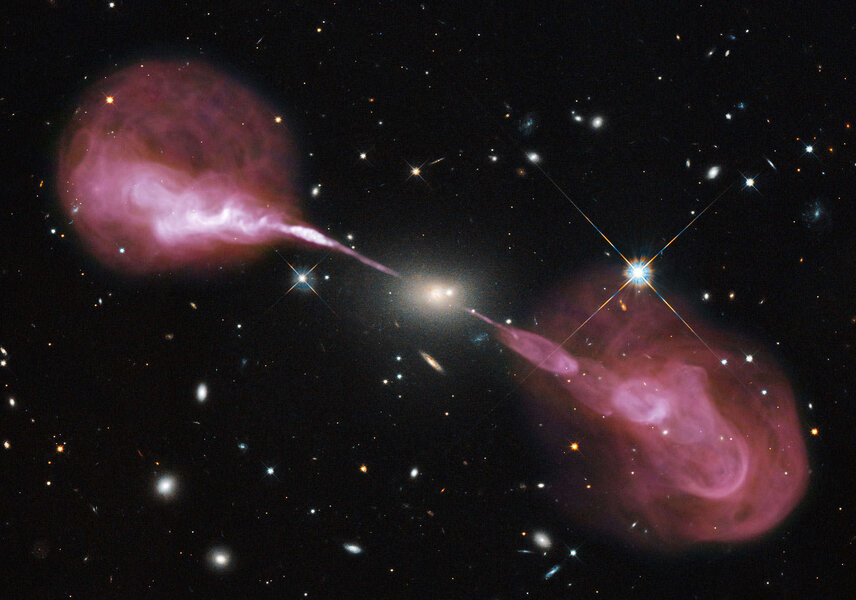Create a free profile to get unlimited access to exclusive videos, sweepstakes, and more!
The ghost of an angry black hole still haunts this galaxy

Some galaxies we see are what we call active: They blast out huge amounts of radiation from their centers, sometimes enough energy to outshine the rest of the galaxy combined. We know this is due to a supermassive black hole in their cores gobbling down matter. The matter forms a disk around it, gets very very hot, and shines exceedingly brightly.
Sometimes, the rotation of that disk (plus, it's now thought, the rotation of the black hole itself) can wind up the magnetic fields in the disk, causing them to form twin vortices, like tornadoes pointing up and down, away from the disk. Matter then gets brutally accelerated along those directions, screaming away in twin beams at very nearly the speed of light. We call those features jets.
That matter decelerates as it plows through the thin material in between galaxies, eventually slowing suddenly and puffing out, forming huge lobes that look like Q-tips… cotton swabs hundreds of thousands of light years across, that is. The jets can extend for millions of light years!
But they don't always do this. Low-resolution images made by radio telescopes of the galaxy PGC 064440 showed it to have a weird X-shaped structure, like it had four jets, not two. Different ideas were proposed to explain this, but a new image from the South African MeerKAT radio observatory has finally cleared up this mystery:
Whoa. When I first saw this I was baffled; I've never seen structure like that before. The long arms of the X are clearly jets, but what are those shorter arms off at an angle? Reading the journal paper, however, made it all clear: This isn't an active galaxy; it used to be an active galaxy!
Those jets were probably launched tens of millions of years ago. But then, for some reason, the black hole in the center of the galaxy shut off (probably when the material in the disk finally ran out). Once that happened the matter stopped flowing out. If it ever had giant lobes they've since dissipated, and the material in the jets started falling back toward the galaxy.
But it couldn't just all flow back in. When it got near the galaxy the ambient gas there caused the infalling jet gas to pile up and deflect to the sides. That's what the short arms of the X are! That's the gas that fell in, got pushed to the side, and is flowing away from the galaxy like backwash (the two inner bright dots may be the jets restarting; perhaps material started falling into the black hole again and the process is cycling up once more).
The galaxy itself isn't visible in this radio image, but observations in visible light show it to be pretty big, bigger than our Milky Way, a disk galaxy something like 150,000 light years across or more. But it's dwarfed by those arms; the long ones stretch 5 million light years end-to-end! For comparison, the Andromeda galaxy is 2.5 million light years from the Milky Way, and on this image above that would be from the center to the end of one of the long arms.
This structure is vast.
And it's so cool! I've never seen anything quite like this. Most active galaxies with jets are still active, with matter still blasting away from the galactic center. This one shut down millions of years ago, so we're seeing the ghosts of jets past, their decaying emission still tenuously echoing their past life.
This sort of thing (called hydrodynamical backflow if you want to drop that into a casual conversation) was predicted to exist years ago, so it's also pretty nice to see that realized.
It always amazes me that there is so much variety to objects in the sky. Galaxies with jets can look radically different depending on circumstances, but it never occurred to me to wonder what they might look like after the black hole was done eating. Well, now we know. You could look all over the sky for something like this and never find one, but in hindsight it should've been easy.
After all, how often does X really mark the spot?





























